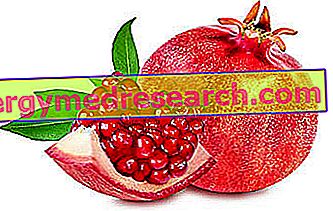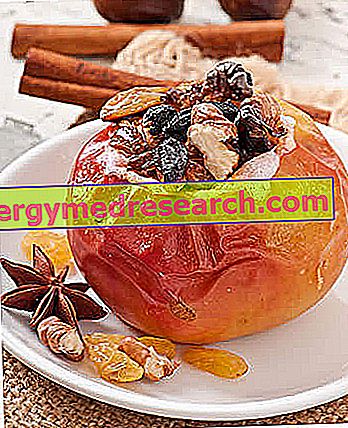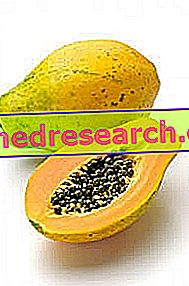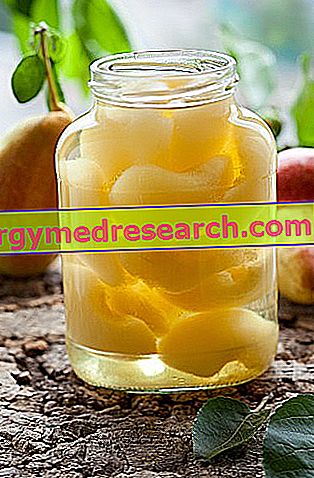A medium-sized peach weighs 120 grams. The edible part is equal to 95% of the product, equal to 115 grams. Amygdalin, a glucoside capable of releasing hydrocyanic acid, is contained in the hazel, which draws about 5 grams. Peach calories Peach nutritional values
Category fruit
What's this What is the pomegranate? The pomegranate is the edible fruit of the pomegranate, ( P. granatum ), a plant native to the area between Iran and the Himalayan chain (in north-eastern India), today widely spread in Italy as well as in the rest of the temperate bands of 'Eurasia, of Africa, of America and of Australia
What are? Cooked apples are a food of a tendentially vegetable origin, with moderate energy intake, sweet taste and beneficial / therapeutic impact, especially towards the "lazy" intestine. As the name suggests, the recipe for cooked apples involves the heat treatment of the fruits; this procedure negatively modifies the chemical profile of the ingredients, even if the food retains however many nutritional qualities
What are Blackberries Blackberries are polidrupa fruits formed by an aggregation of small drupes placed on the same convex receptacle (they belong to the category of aggregated or compound fruits ). Generally, for blackberries we mean the blackberries , or the fruits of Rubus ulmifolius (also known as Rubus fruticosus L
What are Nectarines, or more precisely nectarine peaches, are fruits - drupes - sweet and fleshy produced by a particular botanical variety of peach. Other names of nectarines are pescanoce and nocepesca. Many use nectarine as a synonym for fishing - especially in the Anglo-Saxon countries (peach = nectarine) - but it is more correct to use this noun to differentiate the botanical varieties of plants that produce fruit with peel without hair (tricoma)
What is fermented papaya? The fermented papaya is an anti-aging supplement. It is a natural extract with antioxidant properties, obtained by pulverizing papaya (exotic fruit) which has undergone microbial fermentation for a long time (optimizing its antioxidant content); is a product known for many years in Japan but only recently publicized by Luc Montagnier, a well-known French Nobel Prize winner and discoverer of the HIV virus and professor of the Pasteur Institute in Paris
What are What are canned pears? Pears in syrup are long-keeping foods that belong to the whole of the preserved fruit and fruit in syrup subset. Fresh pears - fruits of the tree belonging to the Pyrus botanical genus - belong to the VII fundamental group of foods - fruits and vegetables rich in vitamin C
Generality Pears are the fruit, or rather the false fruit, of trees of the genus Pyrus , belonging to the Rosaceae family (subfamily Pomoidee), spontaneous in the humid - temperate areas of Europe and Asia. In the fruit category, pears are one of the most consumed and marketed products, both in Europe and in Italy, where some varieties of the sativa sub-species are favored; NB
Generality Peaches are the fruits of peach ( Prunus persica L. Batsch.), A tree plant closely related to other fruit trees in Italy, such as those that produce: plums, apricots, cherries, sour cherries, almonds, etc. Peaches are typically summer foods, aromatic, with a sweet taste and rich in water, fiber, mineral salts and vitamins
What are Peaches in syrup are long-term foods that belong to the whole of the preserved fruit and fruit in syrup subset. Peaches, like all fresh fruits, belong to the VI-VII fundamental group of foods - fruits and vegetables rich in vitamin A and vitamin C. However, once processed for processing into "preserves" - washing, peeling, pitting, cooking and invasions in a sweet liquid - they no longer have the same nutritional characteristics as fresh fruit
What's this What is pitaya? Pitaya, pitahaya or dragon fruit - "dragon fruit" in English - is the name of a fruit originating in Central and South America, produced from the cacti (Family Cactaceae) of the genus Stenocereus and Hylocereus . It is a tropical fruit that, also thanks to the numerous extra continental plantations - for example in South East Asia and in Australia - is rapidly expanding also in the commercial network of the Old Continent











